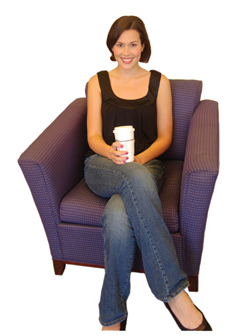A latte to think about
We need to remember that even a cup of joe leaves an environmental footprint.
A latte to think about
We need to remember that even a cup of joe leaves an environmental footprint.
Consider a latte and your morning newspaper. Almost every day sensationalized headlines scream doom and gloom about environmental issues, in particular global warming. Sea levels will rise, small fishing villages will disappear and major coastal cities will be devastated. And somehow we are solely responsible.

Are such accusations fair? Let’s face it, until a few years ago we didn’t know that if we bought a fuel-hogging vehicle we would be contributing to glacial melting in Greenland.
Still, the lifestyles of the 20th century created a problem that we have inherited. Now that the burden lies upon our shoulders, we must ask ourselves, “What we can do about it?”
First, let’s get back to that latte. When we think about our morning beverage, usually Starbucks or a favorite café comes to mind. Rarely do we think about where that coffee comes from or all that goes into bringing that paper cup to our lips. Not to mention where they get the milk, espresso shot, container and sleeve.
No one’s asking you to give up that latte for the environment, but to better understand our impact we must look at what goes into making our cherished cup of joe.
The milk likely comes from a commercial dairy farm with milking machines, put into cartons, sealed, and then driven hundreds of miles to town in a refrigerated truck. Having reached Starbucks, the milk is steamed to a foamy, delectable 160 degrees by a cappuccino maker run by electricity most likely originating from a coal-burning power plant several hundred miles away. The cappuccino maker then pulls a shot of espresso from coffee beans grown in Columbia that were harvested, roasted, shipped and driven in another huge truck to Starbucks.
The cup that holds the latte is hopefully made from paper instead of polystyrene, with 10 percent post-consumer recycled fiber and 90 percent new trees that are bleached. The paper is shaped into a cup, coated inside to make it impermeable, and finally labeled with the Starbucks logo.
The plastic lid is made of petroleum products, the sleeve is manufactured with 60 percent post-consumer fiber and all of it is transported in yet another semi-truck. Environmentally speaking, a lot goes into a latte.
By changing the way we think about everyday items like a cup of coffee, we can truly start to understand the environmental challenges we face and what personal changes might be necessary for a lower-impact lifestyle.
Until we consider the true extent of our ecological impact, significant change is unlikely. By reflecting on where our food came from, what sort of chemicals and energy went into the packaging, and what fuel was used for transportation, we begin to realize that there is a cost beyond the one we pay the checker.
Everything has its own ecological footprint. Everything that goes into bringing commodities to the consumer – including materials, packaging, transportation and often marketing – impacts our Earth.
When we choose an apple from Washington over an apple from New Zealand, we recognize which items have a lower environmental impact. And we can start to make small changes in our choices that collectively can have a large effect.
The cumulative result of small changes should not be underestimated. Many people have seen Al Gore’s environmental soapbox documentary, An Inconvenient Truth (www.climatecrisis.net/), so we know the astounding statistics.
The unforeseen consequences of industrialization got us into this predicament, and the fast-paced progress following the Industrial Revolution blindsided us with many negative and unexpected side effects. Our cumulative and collective actions caused the problems – but they can also be our solution. By making small changes in a positive direction, we will make a difference.
In Texas, where bigger is better and more is the norm, going green is often associated with tree-hugging, Birkenstock-wearing hippies from Austin. However there is a new, positive image for going green that has spread beyond socioeconomic, cultural and political boundaries.
Even major corporations like GE and Starbucks are taking strides towards environmentally friendly capitalism. It is not just a cultural trend anymore. This is our next major cultural shift. We are at a crucial point where our own longevity is dependent on our consideration for the environment and the services it provides.
Maybe I am an idealist, maybe just a dreamer, but I’d love to think we, in this generation, will leave the world a better place for our children.
As an aspiring environmental scientist with a father in the oil industry, my family has the proverbial oil and water at our house all the time. Living in Fort Worth is a constant struggle for balance, knowing we need to be more energy efficient and live more clean, yet still needing individual and convenient transportation in a spread-out town such as this.
In the face of such challenges, the individual choices that we make daily really do make a difference.
Lauren Geffert ’07 is currently a barista at Starbucks, but in the fall she heads to England to begin work on a master’s degree in environmental change and management at the University of Oxford.
On the Web:
www.realclimate.org/
www.begbroke.ox.ac.uk/climate/interface.html
www.eere.energy.gov/greenpower/
www.carbonfund.org/

Your comments are welcome
Comments
Related Reading:
Personal Essay
The Atlantic Slave Trade Bus Tour
How a cultural tour connected the past with the present.
Personal Essay
The Good and the Band of Marching
Appreciating the value of the band community, if not the rain and heat.